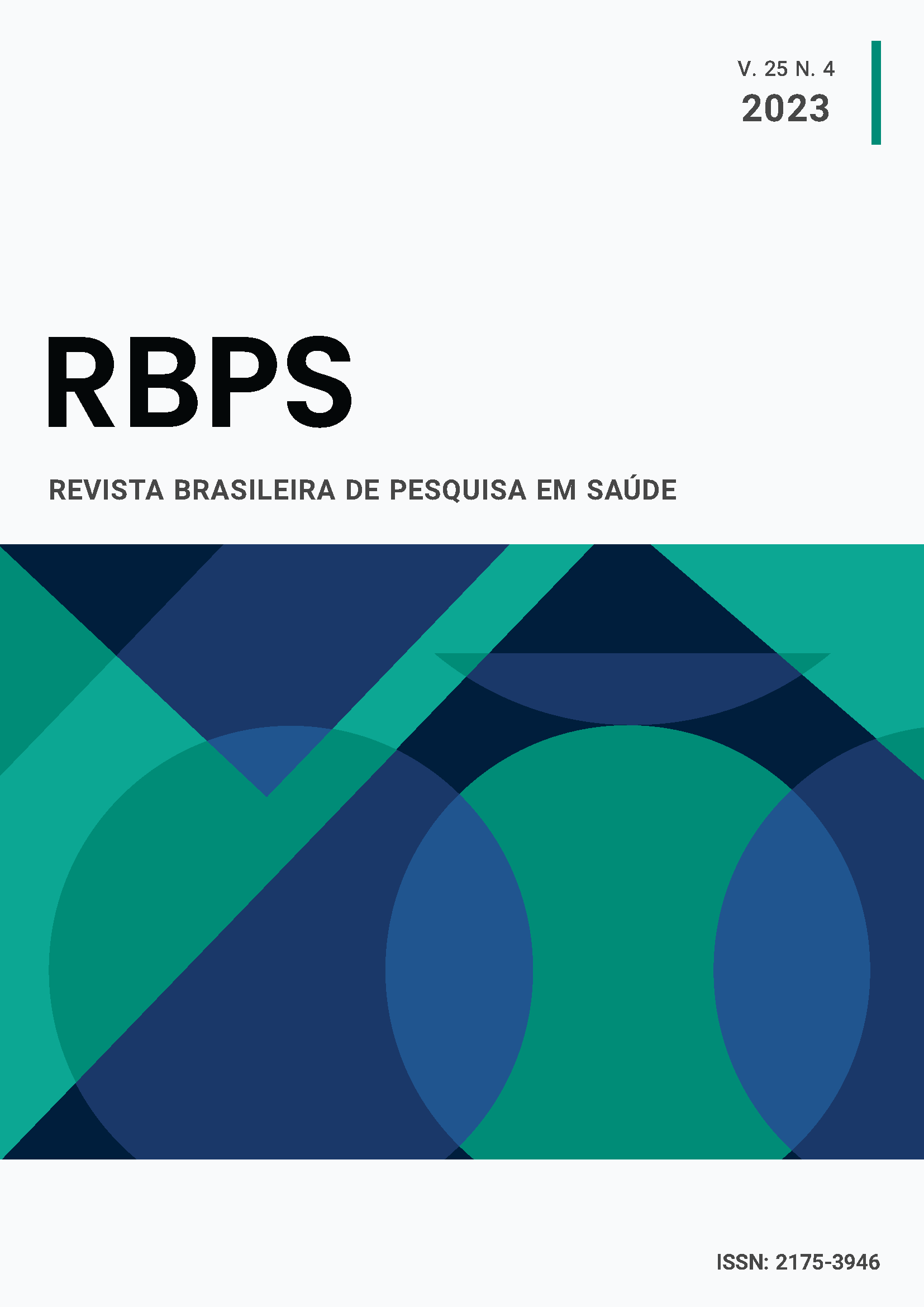Technologies available for the internal audit process in risk classification: integrative review
DOI:
https://doi.org/10.47456/rbps.v25i4.41760Keywords:
Clinical protocols, Technology, Risk assessment, Emergency nursingAbstract
Introduction: Risk classification is a clinical and organizational strategy to minimize risks and harm arising from divergences generated by access to care in health services. The technologies available for the internal audit process may generate evidence capable of ensuring the improvement/readaptation of the technologies already used in this process. Objective: To identify the technologies available for the internal audit process in risk classification. Methods: Integrative review, whose search took place during the month of May 2020, in the Latin American and Caribbean Literature in Health Sciences (LILACS), Library of Medicine National/PubMed, Cochrane Library and Specialized Bibliographic Databases in the Nursing Area (BDENF). The sample consisted of six articles. Results: Six articles were identified that portrayed the following technologies, such as the nursing triage sheet and clinical record forms; the audit protocol with feedback and the presence of facilitators; a Consensus approach and formal guidelines; consensus approach and formal guidelines; pre and post test screening; clinical audit design based on five key areas and assessed against 12 criteria: arrival and triage, documentation, policy compliance, communication, and triage staff; and standard instrument, audit of medical records and interviews. Conclusion: There are weaknesses in relation to the screening method used in institutional protocols, as well as their absence. There are few studies developed on the theme and need for recycling of health professionals involved.
Downloads
References
Ortiga AMB. Classificação de risco. Florianópolis: Universidade Federal de Santa Catarina; 2017.
Dias ESS. Classificação de Risco: Dificuldades enfrentadas pelos enfermeiros. [Monografia]. Florianópolis: Universidade Federal de Santa Catarina; 2014.
Amaro ALT, Ferreira JAG, Silva LDL. As dificuldades encontra¬das por enfermeiros na implantação da classificação de risco em um setor de emergência de uma unidade hospitalar do interior paulista. [Dissertação]. São Paulo: Unisalesiano; 2016.
Albino RM, Grosseman S, Riggenbach V. Classificação de risco: uma necessidade inadiável em um serviço de emergência de qualidade. Santa Catarina: Arquivo Catarinense de Medicina; 2010.
Rafael MS, Portela S, Sousa P, Fernandes A. Utilização do serviço de urgência pediátrica: a experiência de um centro português. Science Med. 2017, 5(1):1-8.
Costa AA, Corazza FH. Desafios enfrentados pelo enfermeiro na realização do acolhimento com classificação de risco em uni¬dades de urgência e emergência. Revista científica eletrônica de ciências aplicadas da FAIT. 2020; 22(1).
Mackway-Jones K, Marsden J, Windle J. Sistema Manchester de Classificação de Risco. 2. ed. Belo Horizonte: Folium; 2017.
Sacoman TM, Beltrammi DGM, Andrezza R, Cecílio LCO, Reis AAC. Implantação do Sistema de Classificação de Risco Man¬chester em uma rede municipal de urgência. Saúde debate. 2019; 43(121).
Whittemore R, Knafl K. The integrative review: updated meth¬odology. [Internet]. J. Adv. Nurs. 2005 [cited 2023 Dec 22]; 52(5):546-53. Available from: 10.1111/j.1365-2648.2005.03621.x
Ursi ES. Prevenção de lesões de pele no perioperatório: revisão integrativa da literatura. [Dissertação]. Ribeirão Preto: Universi¬dade de São Paulo; 2005.
Melnyk BM, Fineout-Overholt E. Evidence-based practice in nursing & healthcare. A guide to best practice. China: Wolters Kluwer/Lippincott Williams & Wilkins; 2011.
Ouzzani M, Hammady H, Fedorowicz Z, Elmagarmid A. Rayyan - a web and mobile app for systematic reviews. [Internet]. Syst. Rev. 2016 [cited 2023 Dec 22]; 5(1):210. Available from: 10.1186/s13643-016- 0384-4.
Boers M. Graphics and statistics for cardiology: designing effective tables for presentation and publication. Heart. 2018; 104:192-200.
Mayo-Wilson E, Li T, Fusco N, Dickersin K, MUDS investiga¬tors. Practical guidance for using multiple data sources in sys¬tematic reviews and meta-analyses (with examples from the MUDS study). Res. Synth. Methods. 2018; 9(1):2-12.
Stovold E, Beecher D, Foxlee R, Noel-Storr A. Study flow dia¬grams in Cochrane systematic review updates: an adapted PRISMA flow diagram. Syst. Rev. 2014; 3:54.
McQueen CP, Gay KJ. Retrospective audit of triage of acute traumatic shoulder dislocation by emergency nurses. J Emerg Nurs. 2010; 36(1):21-5.
Charrier L, Allochis MC, Cavallo MR, Gregori D, Cavallo F, Zotti CM. Integrated audit as a means to implement unit proto¬cols: a randomized and controlled study. J Eval Clin Pract. 2008; 14(5):847-53.
Goodacre S W, Gillett M, Harris RD, Houlihan KP. Consistency of retrospective triage decisions as a standardised instrument for audit. J Accid Emerg Med. 1999; 16(5):322-4.
Stephens GS, Pokorny ME, Bowman JM. The effects of in-service education on the institution of triage protocols. J Nurs Staff Dev. 1997; 13(4):189-92.
Burgess L, Kynoch K, Hines S. Implementing Best practice into the emergency department triage process. Int J Evid Based Healthc. 2019; (1):27-35.
Rankin JA, Then KL, Atack L. Can emergency nurses’ triage skills be improved by online learning? Results of an experiment. J Emerg Nurs. 2013; 39(1):20-6.
Simon Junior H, Schvartsman C, Sukys GA, Farhat SCL. Pedi¬atric emergency triage systems. Revista paulista de pediatria: órgão oficial da Sociedade de Pediatria de São Paulo. 2022; 41.
Wolf LA, Delao AH, Perhats C, Lua MD, Zavotsky KE. Triagem do departamento de emergência, não do paciente: a experiência dos enfermeiros de emergência dos Estados Unidos no processo de triagem. J Emerg Nurs. 2018; 44(3):258-266.
Viana CD, De Bragas LZT, Lazzari DD, Garcia CTF, De Moura GMSS. Implantação da auditoria concorrente de enfermagem: um relato de experiência. Texto contexto enfermagem. 2016; 25(3).
Cicolo EA, Peres HHC. Registro eletrônico e manual do sistema Manchester: confiabilidade, precisão e avaliação de tempo. Rev Lat Am Enfermagem. 2019.
Tam HL, Chung SF, Lou CK. Uma revisão da precisão da triagem e direção futura. BMC Emerg Med. 2018; 18(1):58.
Ferretti F, Romancini F, Schneider LR, Ferraz L. Prática base¬ada em evidência no contexto dos núcleos de apoio a saúde da família em Chapecó. Cogitare Enferm. 2018; 23(2):e52774.
2Kim HJ, Jovem HK. Efeitos de um programa coreano de apren¬dizado de escala de triagem e acuidade baseado na Web na autoeficácia da triagem e na capacidade de desempenho da tria¬gem para enfermeiros no departamento de emergência. J Korean Acad Nurs. 2019; 49(2):171-180.
Downloads
Published
Issue
Section
License
Copyright (c) 2023 Brazilian Journal of Health Research

This work is licensed under a Creative Commons Attribution-NonCommercial-NoDerivatives 4.0 International License.
Authors and reviewers must disclose any financial, professional, or personal conflicts of interest that could influence the results or interpretations of the work. This information will be treated confidentially and disclosed only as necessary to ensure transparency and impartiality in the publication process.
Copyright
RBPS adheres to the CC-BY-NC 4.0 license, meaning authors retain copyright of their work submitted to the journal.
- Originality Declaration: Authors must declare that their submission is original, has not been previously published, and is not under review elsewhere.
- Publication Rights: Upon submission, authors grant RBPS the exclusive right of first publication, subject to peer review.
- Additional Agreements: Authors may enter into non-exclusive agreements for the distribution of the RBPS-published version (e.g., in institutional repositories or as book chapters), provided the original authorship and publication by RBPS are acknowledged.
Authors are encouraged to share their work online (e.g., institutional repositories or personal websites) after initial publication in RBPS, with appropriate citation of authorship and original publication.
Under the CC-BY-NC 4.0 license, readers have the rights to:
- Share: Copy and redistribute the material in any medium or format.
- Adapt: Remix, transform, and build upon the material.
These rights cannot be revoked, provided the following terms are met:
- Attribution: Proper credit must be given, a link to the license provided, and any changes clearly indicated.
- Non-Commercial: The material cannot be used for commercial purposes.
- No Additional Restrictions: No legal or technological measures may be applied to restrict others from doing anything the license permits.

























